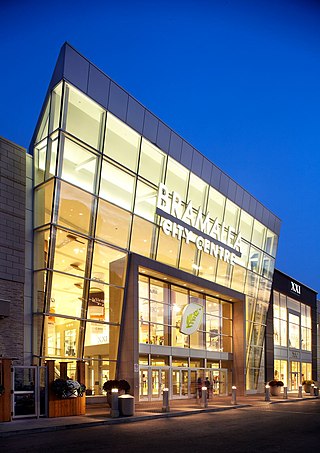Related Research Articles

The Seagram Company Ltd. was a Canadian multinational conglomerate formerly headquartered in Montreal, Quebec. Originally a distiller of Canadian whisky based in Waterloo, Ontario, it was in the 1990s the largest owner of alcoholic beverage lines in the world.

BCE Inc., an abbreviation of its full name Bell Canada Enterprises Inc., is a publicly traded Canadian holding company for Bell Canada, which includes telecommunications providers and various mass media assets under its subsidiary Bell Media Inc. Founded through a corporate reorganization in 1983, when Bell Canada, Northern Telecom, and other related companies all became subsidiaries of Bell Canada Enterprises Inc., it is one of Canada's largest corporations. The company is headquartered at 1 Carrefour Alexander-Graham-Bell in the Verdun borough of Montreal, Quebec, Canada.

The Bramalea City Centre is a large shopping mall located in the city of Brampton, Ontario, Canada. With over a 1.5 million square feet of retail space and more than 300 outlets, it is one of Canada's largest shopping malls. Regarded as a super regional mall, the Bramalea City Centre has a market of more than 500,000 residents and attracts 16 million visitors annually. The Bramalea City Centre is located near the intersection of Queen Street and Dixie Road, just east of Highway 410.

Brookfield Corporation is a Canadian multinational company that is one of the world's largest alternative investment management companies, with over US$725 billion of assets under management in 2022. It focuses on direct control investments in real estate, renewable power, infrastructure, credit and private equity. The company invests in distressed securities through Oaktree Capital, which it bought in 2019. Brookfield's headquarters are in Toronto. It also has corporate offices in New York City, London, São Paulo, Mumbai, Shanghai, Dubai, and Sydney.

Brookfield Properties is a North American subsidiary of commercial real estate company Brookfield Property Partners, which itself is a subsidiary of alternative asset management company Brookfield Asset Management. It is responsible for the property management of the company's real estate portfolio, which includes facilities in the office, multi-family residential, retail, hospitality, and logistics industries.

Noranda Inc. was a mining and metallurgy company originally from Rouyn-Noranda, Quebec, Canada. It was listed on the TSX under the symbol NRD.LV. After eventually acquiring a large interest in rival mining company Falconbridge, it merged with that company in 2005. The combined company continued under the name Falconbridge Limited, ending the Noranda name. Only one year later in 2006 Falconbridge was acquired by the Swiss-based mining company Xstrata. On 2 May 2013 ownership of Xstrata was fully acquired by mining behemoth Glencore.
The Bronfman family is a Canadian family, known for its extensive business holdings. It owes its initial fame to Samuel Bronfman (1889–1971), the most influential Canadian Jew of the mid-20th century, who made a fortune in the alcoholic distilled beverage business during American prohibition, including the sale of liquor through organized crime, through founding the Seagram Company, and who later became president of the Canadian Jewish Congress (1939–62).

Olympia & York was a major international property development firm based in Toronto, Canada. The firm built major financial office complexes including Canary Wharf in London, the World Financial Center in New York City, and First Canadian Place in Toronto. It went bankrupt in the early 1990s and was recreated to eventually become Olympia & York Properties.
Edward Maurice Bronfman, was a Canadian businessman, philanthropist, and member of the Bronfman family.

Simon Property Group, Inc. is an American real estate investment trust that invests in shopping malls, outlet centers, and community/lifestyle centers. It is the largest owner of shopping malls in the United States and is headquartered in Indianapolis, Indiana. Worldwide, it owns interests in 232 properties as of 2021.
Peter Frederick Bronfman, OC was a Canadian businessman and entrepreneur, born in Montreal, and member of the Toronto branch of Canada's wealthy Bronfman family. He attended Selwyn House School in Montreal and the elite Lawrenceville School in New Jersey, one of the oldest prep schools in America, and received his bachelor's degree from Yale University in 1952.
Foreign ownership of companies of Canada pertains to the majority-ownership of Canadian-based assets by non-Canadian individuals or companies, as well as to companies that are effectively owned or controlled, directly or indirectly, by non-Canadians. "Non-Canadian," for all intents and purposes, refers to entities based outside of Canada and to those who are not Canadian citizens or qualified permanent residents.
The Woodbridge Company Limited is a Canadian private holding company based in Toronto, Ontario. It is the primary investment vehicle for members of the family of the late Roy Thomson, 1st Baron Thomson of Fleet. David W. Binet has been the president and chief executive officer of the company since 2012.

Trizec Properties, Inc., previously known as TrizecHahn Corporation, was a real estate investment trust headquartered in Chicago, Illinois. It was originally a Canadian company. The name is derived from the initials of the three groups (Tri) that formed Trizec Properties Ltd: Zeckendorf, Eagle Star, and Covent Gardens.
Brookfield Infrastructure Partners L.P. is a publicly traded limited partnership with corporate headquarters in Toronto, Canada, that engages in the acquisition and management of infrastructure assets on a global basis.
Brookfield Renewable Partners L.P. is a publicly traded limited partnership that owns and operates renewable power assets, with corporate headquarters in Toronto, Ontario, Canada. It is 60% owned by Brookfield Asset Management.

China Asset Management Co., Ltd. is one of China's biggest fund families. The company offers investment managers of National Social Security Fund, corporate annuities, Listed Open-end Fund (LOF), Qualified Domestic Institutional Investor (QDII) funds and Qualified Foreign Institutional Investor (QFII) funds, etc. It is the first exchange-traded fund (ETF) manager in China, and the sole investment manager of Asian Bond Fund China Fund. The company is the first in the industry to initiate the investment philosophy of Research Creates Value.

Gulf Canada was a Canadian integrated petroleum company that existed between 1944 and 2001. Gulf Oil Corporation began operating in Canada in 1942, and two years later formed a Canadian subsidiary called the Canadian Gulf Oil Company. In 1956 Canadian Gulf Oil merged with the British American Oil Company and until 1969 operated under the British American name. In 1969, British American amalgamated with its subsidiaries into a new company called Gulf Oil Canada Limited.
Cemp Investments was the primary holding company and investment vehicle for, and named after, the four children of Samuel Bronfman: Charles Bronfman, Edgar Bronfman, Aileen "Minda" Bronfman de Gunzburg, and Phyllis Lambert, also known as the Montreal branch of the Bronfman family. Cemp became one of the largest privately owned companies in Canada. At its peak, it controlled tens of billions in dollars of assets in major distilling, commercial real estate development, oil and gas, and entertainment companies across North America.
The Royal Trust Company is a Canadian trust company that was founded in 1892 in Montreal, Quebec. By the late 20th century, it carried out trust, financial, real estate and deposit services in over 100 branches in Canada, the U.S. and overseas. In 1993, the company was bought by the Royal Bank of Canada, and Royal Trust is now part of RBC Wealth Management.
References
- ↑ Bronfman dies, The Global Jewish News Source, April 6, 2005. Retrieved 2015-04-14
- 1 2 David Strangeland, In High Gear: A Case Study of the Hees-Edper Corporate Group, January 1, 1995. Retrieved 2015-04-19
- ↑ Peter F. Bronfman industrialist dies at 67, New York Times, December 3, 1996. Retrieved 2015-04-16
- 1 2 3 4 5 6 Brascan Corporation history. Retrieved 2015-04-18
- 1 2 Brookdfield Corporate History Archived 2016-03-04 at the Wayback Machine . Retrieved 2015-04-16
- 1 2 3 4 The controlling hand of the Edper empire, The Independent, February 14, 1993 (reprinted form the original). Retrieved 2015-04-16
- 1 2 The Rich 100: The man behind Brascan, Canadian Business, December 4, 2006. Retrieved 2015-04-20
- ↑ Northern Exposure, Southern Investigative Reporting Foundation, March 11, 2013. Retrieved 2014-04-18
- ↑ Price biggest surprise in sale of the Habs, Ottawa Journal, December 31, 1971. Retrieved 2015-04-6
- ↑ Acquisition of the Montreal Canadiens, University of Sherbrooke, December 30, 2013. Retrieved 2015-04-18
- ↑ Molson family reaches deal to purchase Canadiens, June 20, 2009. Retrieved 2015-04-18
- ↑ Gillett agrees to sell Canadiens to Molson family, CBC, Jun 20, 2009. Retrieved 2015-04-18
- ↑ Montreal Canadiens - Habs owners through the years Archived 2014-12-25 at the Wayback Machine . Retrieved 2015-04-18
- ↑ Brookfield Properties Corporation, Encyclopedia.com. Retrieved 2015-04-19
- 1 2 S.E.C. Renewal Annual Information Form, Brookfield Properties, March 28, 2013. Retrieved 2015-04-19
- ↑ From Olympia and York bankruptcy, a new company. New York Times, December 15, 1996. Retrieved 2015-04-19
- 1 2 3 Trizec Corporation Ltd. history, Funding Universe. Retrieved 2015-04-18
- ↑ Reference for Business, Bramalea Ltd.. Retrieved 2015-04-18
- ↑ Bankruptcy for Bramalea, New York Times, December 24, 1992. Retrieved 2015-04-18
- ↑ Newport Beach builder files for bankruptcy, Los Angeles Times, May 18, 1995. Retrieved 2015-04-18
- ↑ Canadian Developer Bramalea goes into bankruptcy, Associated Press, Apr. 27, 1995. Retrieved 2015-04-17
- ↑ Trizec Corporation history, Funding Universe. Retrieved 2015-04-18
- ↑ Bell Canada, Los Angeles Times, February 3, 1985. Retrieved 2015-04-19
- ↑ Daon Development Corporation, McGill University Digital Library. Retrieved 2015-04-16
- ↑ BCE Development Changes Its Name, Chicago Tribune, July 3, 1990. Retrieved 2015-04-19
- ↑ Northern Miner, February 22, 1988. Retrieved 2015-04-20
- ↑ Brascan strategy could shake up investment circles, Ottawa Citizen, August 2, 1984. Retrieved 2015-04-20
- ↑ S.E.C. filing Brascan Power Inc – ‘40-F’ for 12/31/03 – EX-99.1m, 2004. Retrieved 2015-04-20
- 1 2 Frisbee, W.R.; Sommers, M.S. (1989). Services in Canada. pp. 93–95. ISBN 9781135184179 . Retrieved 2015-04-18.
- ↑ Roland H. Webb, Burrard Drydock Co. Ltd.: The Rise and Demise of Vancouver's Biggest Shipyard. Canadian Nautical Research Society, Volume 6. Retrieved 2015-04-18
- ↑ Konrad Yakabuski, The Politics of Financial Sector Refor, McGill University thesis, 1987. Retrieved 2015-04-21
- ↑ Carroll, William K. (2011). Corporate Power and Canadian Capitalism. UBC Press. p. 179. ISBN 9780774844932 . Retrieved 2015-04-18.
- ↑ The Canadian Encyclopedia. Retrieved 2015-04-19
- ↑ Canadian Corporate Reports, McGill Digital Archive
- ↑ "I dreamt the island was for sale", interview with Christopher Ondaatje, The Financial Times, January 4, 2008. Retrieved 2015-04-17
- ↑ Roy Macskimming, The Perilous Trade: "Book Publishing in Canada, 1946-2006, P.307. McClelland & Stewart, Toronto, 2003-2007. ISBN 978-0-7710-5494-5. Retrieved 2015-04-16
- ↑ Legacy of a bootlegger, The Independent, February 14, 1993. Retrieved 2015-04-17
- ↑ Brascan Ltd. Vs. Edper Equities Ltd., United States District Court, S. D. New York. Revised June 7, 1979. Retrieved 2015-04-19
- ↑ Lusztig/Schwab, Managerial Finance in a Canadian Setting, Fourth Edition. Retrieved 2015-04-016]. Retrieved 2015-04-19
- ↑ Brascan hurt over Woolworth, Chicago Tribune, June 3, 1979. Retrieved 2015-04-19
- ↑ A Bronfman empire stumbles, New York Times, October 23, 1990. Retrieved 2015-04-19
- ↑ Armstrong, Christoper (2001). Moose Pastures and Mergers: The Ontario Securities Commission and the Regulation of Share Markets 1940-1980 . University of Toronto Press. p. 320. ISBN 9780802035103 . Retrieved 2015-04-19.
- 1 2 3 Noranda Inc. history, Funding Universe. Retrieved 2015-04-18
- ↑ Union Pacific Resources to buy Norcen in $3.5 billion deal, Oil and Gas Journal, February 2, 1998. Retrieved 2015-04-19
- ↑ Brookfield Americas Infrastructure Fund presentation, September 20, 2010. Retrieved 2015-04-18
- ↑ Bronfmans pulling out of Labatt, New York Times, February 13, 1992. Retrieved 2015-04-18
- ↑ Labatt Brewing Company history, Funding Universe. Retrieved 2015-04-18
- 1 2 3 4 Trilon Financial Corporation history, Funding Universe. Retrieved 2015-04-18
- ↑ Funding Universe, Olympia and York Developments. Retrieved 2015-04-19
- ↑ Brascan Financial corporate webpage.
- ↑ History says Brascan will top of Trilon bid with a cherry, The Globe and Mail, Mar. 27 2002, updated 2009. Retrieved 2015-04-18
- ↑ $8.9B deal merges Trizec, Brookfield, The Montreal Gazette, June 6, 2006. Retrieved 2015-04-18